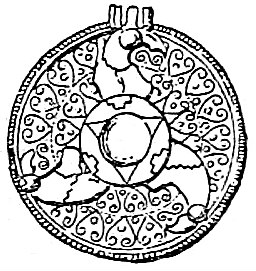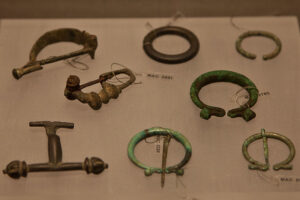Fibulae: The Brooches of the Ancient World
Fibulae are an archeological family of brooches that fastened clothing and outerwear, pre- buttons and zippers. There is a semantics disagreement here: the British Isles uses the term limitedly for Continental European items, while elsewhere the term is used with greater abandon. (Try searching “fibula” on the British Museum website versus the MET.)
For our purposes, we’ll use the broader definition of fibula that takes in brooches from across the world from Berber cultures to the Byzantine Empire to Celtic cultures. This definition
includes any pin-style “brooch”, with a body, pin, and spring or hinge.
From this vast assortment, fibulae are sorted into three classes: penannular, bow, and plate.
Bow Fibulae

1) An artistic rendering of a fibula found in King Childeric’s (481 CE) tomb
The earliest bow fibulae were carefully constructed from a single piece of bronze—pin, spring, body, and all.
These single-piece bows were made from around 450 BCE to the end of the first century CE.
The middle of that first century marked the advent of the two-piece bow fibula with a body and separate spring pin. These remained popular into the 400s.
For a short time in the 1 st century, bow fibulae with spring sleeves were made as well. The solution didn’t catch on but was retried here and there throughout the next few centuries.
Bow fibulae look like miniature bows or harps in side profile. The curved body was sometimes just for looks but could also hold more cloth than other fibula styles.
Styling for bow fibulae ranged from straightforward thin pieces of bronze to elaborate bodies with engravings, insets, and more.
Some of the earliest bow pins (those thin pieces of bronze) featured a small bead, often amber or glass, on the body part.
Another option was adding sheet-bronze emblems suspended on fine chain, for a “noisemaker” effect.
Crossbow Fibulae

A classic of the late Roman era was adding arms to the bow body to form a crossbow fibula. Crossbow fibulae have been sorted into groups themselves based on style changes through the third and fourth centuries CE:
- Type I had small, simple top knobs and a short foot (the flat bit where the pin is secured).
- Type II featured larger knobs and a longer foot.
- Type III displayed highly decorated feet longer than the bodies.
Penannular Fibulae
2) A collection of crossbow and penannular fibulae
Penannular, from Latin “paene” and “ānulāris”, means “almost ring-shaped”, which explains these fibulae quite accurately.
Penannular fibulae are a straight pin attached to a partial ring with a small opening, large enough for the pin. The pin is put through fabric like a typical straight pin, then flipped up over the edge of the ring, which is rotated so that the pin is resting on top—pinning the cloth inside the loop.
These fibulae were used from about 50 BCE to 400 CE, across a myriad of styles and cultures. The ring bodies could be coiled or engraved. The terminals: folded over, knobbed, curled, or any variety of imaginative solutions.
More elaborate were the zoomorphic terminals popular among the Celts.
Omega penannular fibulae were a specific type inspired by the Greeks. These fibulae had terminals that turned outwards to form the Greek letter Ω (omega).
“Viking” penannular fibulae featured large triangular legs. They’re commonly associated with Vikings, but that’s a bit misapplied as they’re more accurately of Finno-Ugric origin.
Roman efforts to dominate the known world helped spread these pins (and many of their variations) into Germanic and British areas in the early centuries CE. While penannular fibulae faded from popularity around 400 CE, they remained in use into the 11th century.
Plate Fibulae

3) A spiral plate
Plate fibulae are the catch-all after bow and penannular fibulae. If a fibula doesn’t qualify as a bow or penannular, it’s a plate. The result: there is a very wide variety of plate fibulae.
Romans favored geometric patterns or letters (S, P, B, M, and N were especially popular), along with zoomorphic designs.
Interestingly, while pins in the shape of Thor’s Hammer are easy to find nowadays, they aren’t historic. Mjölnir pendants were common tokens, but plate fibulae from the Norse region were more commonly curved ovals or flat circles with geometric designs.
Anglo-Saxons had their take on geometric patterns too, with a higher emphasis on including zoomorphic designs.
Plate fibulae were initially used individually. Rarer examples have two plates connected by a bow piece.
But another variety was two plates with chainwork strung between them. This variety would develop into a Medieval style used to secure cording like we explored over here.
Our definition of “fibula” largely ends in the late Roman era, around 400 CE. However, the mechanism remained a mainstay of style for centuries, as brooches remained a critical part of finishing outfits or securing cloaks and capes.
Even today, though brooches are mostly heirloom pieces now, safety pins remain a favorite of emergency fashion rescues and last-minute solutions.
